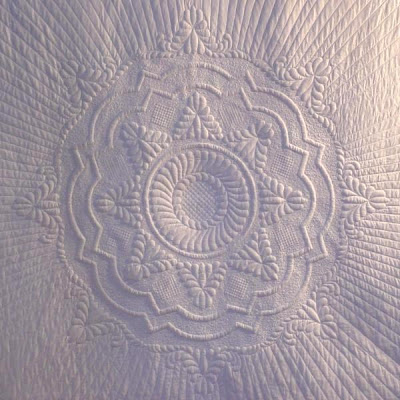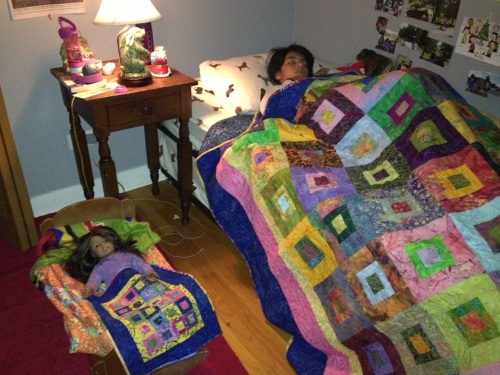Even with the basic quilting atoms I’ve mentioned that scary word — UNITS. When quilters stare at a quilt we’re imposing an imaginary grid over what we’ve established as the blocks and deciding how we’d piece the block. The grid helps us determine how the pieces are proportional to each other, and since we may or may not want to recreate the quilt pattern at the same overall size, that’s important.
So what’s the deal with units anyway? What does that really mean? How big can a quilting atom be? Or how small?
The answer is that atoms in a particular quilt can be as big or as small as you want it to be, an answer sure to vex beginning quiltmakers. That’s why I think of units as YOU-nits. You get to decide how big the unit is, the size that everything else will be proportionally based on. How wonderful or awful depending on how much in control you like to be (you know who you are) or how phobic of anything math-y or even smacks of numbers you are.
On the large end of size of quilting atoms, you could skip piecing all together and simply make your quilt top, square or rectangle, as large as your bed or wall space. It could be all one color or a huge print or a hand-dyed masterpiece. Quilters call these quilts ‘wholecloths’ by the way and it tends to imply that the quilting is what then defines and ‘makes’ the quilt. Here’s a lovely example by Pieced Pastimes:
So that’s on the large end. What about the small side of things? Well some quilters do find the small side of piecing a delightful challenge and are pushing the boundaries of how small they can make the individual pieces. There’s a whole art of miniature quilts that boggles my mind! Here’s a sweet example of a twin-sized quilt and its doll-sized copy. The blocks are 8″ on the larger quilt and 2″ on the smaller one.
See, it’s all about proportion and scale. Which I’ll say more about in a moment.
So if I say that a rectangle in a quilting block is two grid units long, how do you know how big the units are?
The short answer is that everything is relative. Just like recipes in cooking, units in quilting are all about relationship. (We won’t go into romantic relationships here, that’s for another blog to cover :)). Or perhaps better said, the units are about proportion. In cooking the base of a basic sauce is often a roux — equal parts of flour and fat. So if you’re making a small amount of base for a family dinner, it’s only a tablespoon or two of each. And if you’re cooking for my dad’s family reunion — or an army (yes I have forty-five first cousins on my dad’s side and he’s one of 15 children) — then you’d better make it a cup of each or more. So you see? The proportions are the same, one unit of each. You just need to pick a beginning size and the other one follows.
So it’s likewise true for units in quilting. First think about your recipient, doll or wall or person or enormous bed, etc. and consider the size quilt you want to wind up with. Think about the size block that might be convenient to work with, and how many smaller pieces might make up each block. Then, begin with the size squares you’re using in your blocks and then base the rectangle size on that in proportion. The part you need to remember is to work in finished sizes until at the last moment adding the seam allowance you’ll need before cutting. For 2″ finished squares for instance, a two grid unit rectangle would be 4″ long. The cut size would be 2.5″ by 4.5″. For 3″ finished squares in your block, a two grid unit rectangle would be 6″ long, and the cut size would be 3.5″ by 6.5″. Both of these examples maintain the same proportion while using a different starting grid size.
What I didn’t understand when I first started quilting is why quilt block dictionaries simply gave a grid drawing of the block and considered that sufficient information for me to build the block. It’s because once you gain some experience and understand the basic building blocks (like how to cut and sew squares and logs and (gasp) triangles) then you can decide the size on your own and use your favorite methods to make the quilt turn out the size and scale you want. Just like in a word dictionary, a block guide relies on your ability to assemble smaller atoms (words) into larger blocks (sentences).
That kind of control makes me crazy happy. If I’m in charge of the block and grid size, I can make the numbers easy (laid back) and play nice with each other. I can take the same block diagram and just by changing the units I can easily scale a pattern from a crib quilt to a California king.
And I can teach you how to do the same thing, which also makes me crazy happy. You can be a happy, self-reliant quilter whose fabric escapades delight friends and scare off foes alike.


